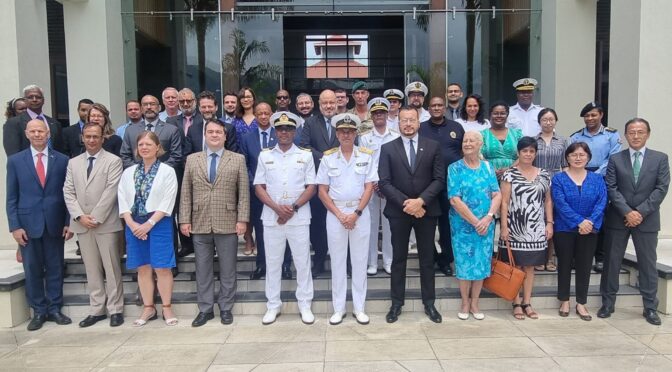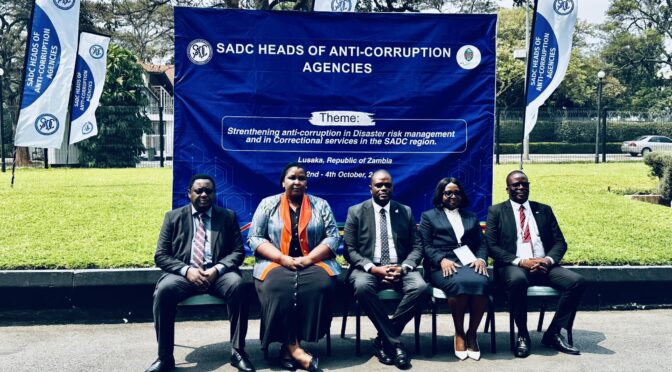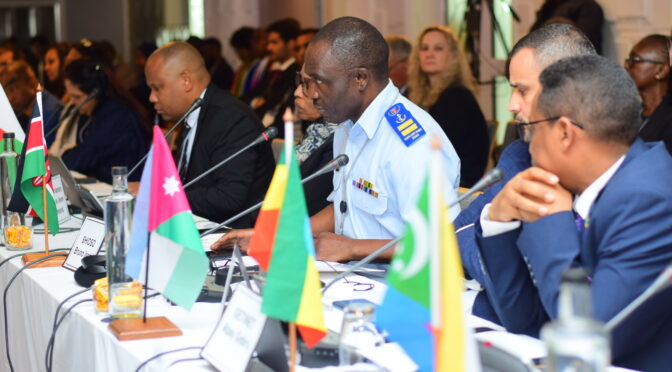By Pascaline Alexandre, Africa Center for Competitive Intelligence (ACCI)
Introduction
In recent years, maritime security in the Western Indian Ocean1 (WIO) has risen to the forefront of global priorities, driven by the rapid expansion of international trade and the strategic importance of the world’s oceans. As shipping lanes grow busier, the threats to safe and open maritime passage – such as piracy, illegal fishing, territorial tensions, and ecological degradation—have become more pronounced. Confronting these evolving challenges requires more than isolated efforts; it calls for a shared understanding of risks, enhanced situational awareness, and robust cooperation among national governments, international organizations, and non-state actors working toward common maritime goals.
The WIO – extending from the shores of Somalia to South Africa and including key island nations – is among the most strategically important maritime regions in the world. It functions as a crucial lifeline for global trade while simultaneously occupying a central position in the contest for geopolitical influence. The region is shaped by intersecting strategic ambitions: Indo-Pacific frameworks, India’s expanding regional role, and China’s far-reaching Belt and Road Initiative. As a result, the WIO has become a focal point of international power projection, where commerce, security, and diplomacy are deeply intertwined.
Amid this high-stakes contest for regional influence, African coastal and island states in the Western Indian Ocean have frequently been relegated to the sidelines—treated more as passive observers than active stakeholders in decisions that directly impact their maritime domains. This marginalization stems in part from what scholars refer to as wealth blindness2 – a persistent undervaluing of the strategic and economic significance of African maritime spaces. Compounding the issue are gaps in institutional capacity, technical expertise, and resources. Yet, change is underway. The narrative is shifting, and regional actors are increasingly asserting their agency in shaping maritime governance on their own terms.
From Fragmentation to Frameworks
The piracy crisis off the Somali coast in the early 2000s exposed deep governance deficits across the WIO. In response, a surge of international coordination emerged – from the Contact Group on Piracy off the Coast of Somalia (CGPCS)3 and the EU-led Shared Awareness and Deconfliction mechanism (SHADE)4 to the Combined Maritime Forces (CMF).5 These were effective but externally driven and focused only on piracy.
Now, that model is evolving.
At the heart of this transformation are two major frameworks: the Djibouti Code of Conduct with its Jeddah Amendment (DCoC-JA)6 and the Regional Maritime Security Architecture (RMSA).7 Together, they exemplify a new African-led narrative that emphasizes sovereignty, cooperation, and coordination.
These frameworks reflect what scholars refer to as a dynamic equilibrium8—a balancing act where regional actors engage in both cooperation and competition without allowing any single power to dominate.9
What is the RMSA?
The establishment of the Regional Maritime Security Architecture (RMSA) was enabled under the Maritime Security (MASE)10 (MASE) Programme, funded by the European Union and implemented by the Indian Ocean Commission (IOC).11 This innovative framework fostered collaboration among a wide range of actors with a shared commitment to securing the maritime domain.
The MASE Programme ended in 2023 and given the significant results achieved by the IOC and various successful operations undertaken under RMSA, the EU agreed to continue funding under the Safe Seas Africa (SSA) initiative.12 The RMSA is anchored in two foundational regional agreements focused on information sharing, coordination, and coordinated maritime operations (collectively referred to as the MASE agreements). At its core are two key regional centers: the Regional Maritime Information Fusion Centre (RMIFC) in Madagascar and the Regional Coordination Operations Centre (RCOC) in Seychelles. These centers work in close cooperation with the national centers of the seven signatory states to operationalize the agreements’ objectives.

Figure 1: Overview of the Two Regional Agreements and the Roles of the Two Regional Centers (RMIFC and RCOC) within the Architecture13
Elevating Regional Maritime Security through IOC Leadership
The IOC has solidified its role as a central actor in maritime security across the Western Indian Ocean. Its contribution has significantly advanced the regional maritime security agenda on the international stage. The IOC has served as the co-chair of the Capacity Building Working Group from 2014, Chair (2018-2020) and participated in the Secretariat since 2016, when Seychelles took the presidency of the Contact Group on Piracy off the Coast of Somalia (CGPCS) (subsequently rebranded as the Contact Group on Illicit Maritime Activities (CGIMA) at the 24th Plenary Session in 2022). This progression has been achieved in collaboration with key regional states in WIO.
The IOC’s active participation in high-profile international forums – including SHADE, the Indian Ocean Naval Symposium (IONS), the 2018 Sustainable Blue Economy Conference hosted by Kenya, and United Nations Security Council annual reporting – has further amplified the voices of African coastal and island states of the WIO in global maritime governance discussions. Acting as the diplomatic engine of the RMSA, the IOC works to build political backing for the region’s maritime centers while fostering dialogue and coordination among a wide range of partners and stakeholders.
Operational Coordination via Regional Centers
At the operational core of the Regional Maritime Security Architecture (RMSA) lie two key centers: the Regional Maritime Information Fusion Centre (RMIFC) in Madagascar and the Regional Coordination Operations Centre (RCOC) in Seychelles. These centers act as hubs for real-time maritime domain awareness, regional coordination, and rapid response to threats through coordinated maritime operations. Working in close cooperation with national centers in the seven signatory states, they also maintain collaborative ties with non-signatory coastal nations such as Tanzania, Mozambique, and South Africa, as well as international partners including EU NAVFOR, CMF, and United States Africa Command (AFRICOM).
Structurally, the RMSA is underpinned by a network of memoranda of understanding, bilateral and multilateral agreements, and operational protocols. While this patchwork model reflects a diversity of interests, priorities, and actors, it also offers the flexibility necessary to adapt to the region’s complex geopolitical and operational landscape.14 By accommodating different levels of commitment and cooperation, the RMSA enables a pragmatic approach to improving regional maritime security governance.
Cultivating African WIO Soft Power
One of the RMSA’s most impactful contributions is its role in cultivating WIO soft power—the capacity to shape maritime governance and diplomacy through legitimacy, cooperation, and strategic vision rather than coercion. This approach aligns with foundational frameworks like the 2050 Africa’s Integrated Maritime Strategy (AIMS)15 and the 2016 Lomé Charter,16 both of which promote African-led maritime governance and sustainable blue economy development.
Rather than relying on externally imposed models, the RMSA represents a turning point toward homegrown solutions, rooted in local context, priorities, and political will. It offers African coastal and island states not just a seat at the table, but the ability to convene it.
Adapting to Evolving Maritime Threats
As maritime threats continue to evolve from piracy and trafficking to broader geopolitical tensions, so too must regional responses. The dynamic nature of today’s maritime environment demands constant recalibration and innovation. In this spirit, the two WIO frameworks, Djibouti Code of Conduct and its Jeddah Amendment (DCoC-JA) and RMSA, are actively seeking to establish a cooperative arrangement. An official correspondence in 2023 confirmed this collaboration.
Going forward, there is a need for concerted efforts by the IOC, in close partnership with the DCoC/JA Steering Committee, to ensure that the RMSA and its two regional centers to build upon, rather than duplicate, the work already undertaken under the DCoC/JA framework. The recent memorandum of understanding signed between the DCoC/JA and the regional centers stands as a concrete example of this alignment, reinforcing the principle of mutually supportive, inclusive cooperation. Together, the RMSA and DCoC-JA are reshaping the narrative around maritime security in the region from one of dependency to one of regional agency and leadership. By amplifying African voices and reinforcing regional ownership, these frameworks are helping to drive a more balanced, cooperative, and sustainable maritime future.
Challenges and the Road Ahead
While the Regional Maritime Security Architecture (RMSA) shows strong promise, it is still in its early days of operationalization with many challenges. Among these are limitations and disparities in national capacity to sustain the RMSA and reliance on donors. On the latter issue, the IOC recognizes the need for sustained international communities support given the shared interest. While there is notable interest from international partners, reflected in initiatives such as observer status to the IOC, ensuring the long-term viability and ownership of the RMSA requires transitioning from external dependency to self-sustained regional mechanisms. Additionally, the intense efforts needed for ensuring coordination may lead to a growing sense of “coordination fatigue,” amid overlapping regional and international initiatives. Moreover, limited visibility in global policy arenas continues to undermine broader recognition of African-led efforts.
Experts argue that tackling these obstacles requires a coherent strategic roadmap, greater investment in local expertise and infrastructure, and deeper engagement with the private sector to ensure sustainability and innovation.
Conclusion
In the WIO, maritime influence isn’t measured solely in fleets and surveillance—it’s also defined by narrative power. Who identifies the threats? Who proposes the solutions?
For decades, African coastal and island nations were largely sidelined in these conversations. Today, through frameworks like the RMSA and DCoC, they are reclaiming agency and rewriting the script.
At its core, the RMSA is more than a coordination platform—it’s a vehicle for regional empowerment. With a focus on maritime domain awareness, legal harmonization, and multilateral action, it gives African coastal and island states of the WIO region, the tools to assert greater control over their maritime future. The RMSA needs to be extended though.
Ms. Pascaline Alexandre is the Deputy Secretary General, Africa Center for Competitive Intelligence (ACCI), a strategic communication and competitive intelligence practitioner. She has been working in the maritime security domain and international cooperation in Eastern, Southern Africa, Indian Ocean (ESA-IO) and Central Africa for over a decade. In this role, she has developed a broad experience in regional cooperation through her work with the EU MASE Programme and the Contact Group on Illicit Maritime Activities (ex CGPCS) via the Indian Ocean Commission. Ms. Alexandre has worked closely with various Regional Economic Communities including COMESA, EAC and IGAD on different maritime issues. She was recently based in Gabon and worked for another EU regional project, supporting the ECCAS in Central Africa in implementing their Maritime Security objectives. Ms. Alexandre holds a Master’s degree in Competitive Intelligence and Strategic Communication from the IAE de Poiters; a Master’s degree in Scientific and Technical Information from the Université de Lorraine, and a BA in French and English communication from the UNISA Charles Telfair Institute.
Endnotes
1. The Western Indian Ocean (WIO) region comprises the Eastern African coastal states of Kenya, Mozambique, Somalia, South Africa and Tanzania as well as the island states of Comoros, Madagascar, Mauritius, Seychelles and the overseas French territories of Mayotte and Reunion.
2. Ian Ralby (2017),“From Sea Blindness to Wealth Blindness,” Stimson Environment Security, February 8, 2017, https://medium.com/natural-security-forum/from-sea-blindness-to-wealth-blindness-2251dd804bf5#.jnne6kc5z
3. Contact Group on Piracy off the Coast of Somalia (CGPCS), https://maritime-executive.com/editorials/un-s-contact-group-on-somali-piracy-changes-its-mandate.
4. Shared Awareness and De-confliction (SHADE), https://combinedmaritimeforces.com/shade-conference-2022/
5. Combined Maritime Forces (CMF), https://combinedmaritimeforces.com/
6. The Djibouti Code of Conduct, The International Maritime Organization, https://www.imo.org/en/OurWork/Security/Pages/Content-and-Evolution-of-the-Djibouti-Code-of-Conduct
7. Raj Mohabeer and Kate Sullivan de Estrada, “Strengthening Maritime Security in the Western Indian Ocean,” Indian Ocean Commission, 2019, https://www.commissionoceanindien.org/wp-content/uploads/2019/10/Strengthening-maritime-security-in-the-western-indian-ocean-policy-brief.pdf.
8. Halifa Alena Kusuma, “Maritime Diplomacy in the ASEAN Maritime Security Strategic Partnership, “Modern Diplomacy, January 24, 2024, https://moderndiplomacy.eu/2024/01/24/maritime-diplomacy-in-the-asean-maritime-security-strategic-partnership/.
9. Miftahul Choir, Joe William and Raihan Zahirah, “The Missing Link between Dynamic Equilibrium Doctrine and Indonesia’s Interest in South Pacific,” in Proceedings of Airlangga Conference on International Relations, 2018, https://www.scitepress.org/Papers/2018/102742/102742.pdf.
10. Maritime Security Programme, https://www.commissionoceanindien.org/securite-maritime-mase/.
11. “Operation Levante 2: A Regional Security Mechanism,” Indian Ocean Commission, August 26, 2024, https://www.commissionoceanindien.org/en/.
12. “Operation Levante 2.”
13. Mohabeer and Sullivan de Estrada, 2019.
14. Christian Bueger, “Who secures the Western Indian Ocean? The need for strategic dialogue,” Center for Maritime Security, September 19, 2024, https://centerformaritimestrategy.org/publications/who-secures-the-western-indian-ocean-the-need-for-strategic-dialogue/.
15. The African Integrated Maritime Strategy (2050 AIM Strategy), https://au.int/sites/default/files/newsevents/workingdocuments/33832-wd-african_union_3-1.pdf.
16. Treaty African Charter on Maritime Security (Lomé Charter), https://au.int/sites/default/files/treaties/37286-treaty-african_charter_on_maritime_security.pdf.
References
Bueger, Christian. “Who secures the Western Indian Ocean? The need for strategic dialogue.” Center for Maritime Security, September 19, 2024. https://centerformaritimestrategy.org/publications/who-secures-the-western-indian-ocean-the-need-for-strategic-dialogue/
Choir, Miftahul, Joe William and Raihan Zahirah. “The Missing Link between Dynamic Equilibrium Doctrine and Indonesia’s Interest in South Pacific,” in Proceedings of Airlangga Conference on International Relations, 2018. https://www.scitepress.org/Papers/2018/102742/102742.pdf
Kusuma, Halifa Alena. “Maritime Diplomacy in the ASEAN Maritime Security Strategic Partnership,” Modern Diplomacy, January 24, 2024. https://moderndiplomacy.eu/2024/01/24/maritime-diplomacy-in-the-asean-maritime-security-strategic-partnership/
Mohabeer, Raj and Kate Sullivan de Estrada. “Strengthening Maritime Security in the Western Indian Ocean.” Indian Ocean Commission, 2019. https://www.commissionoceanindien.org/wp-content/uploads/2019/10/Strengthening-maritime-security-in-the-western-indian-ocean-policy-brief.pdf
“Operation Levante 2: A Regional Security Mechanism.” Indian Ocean Commission, August 26, 2024. https://www.commissionoceanindien.org/en/
Ralby, Ian. “From Sea Blindness to Wealth Blindness.” Stimson Environment Security, February 8, 2017. https://www.stimson.org/2017/sea-blindness-wealth-blindness/
Ruo-Yao Fan, Jing-Yi Xie, Jai-Jun Liu, Hui-Ying Wang, Meng-Xuan Li, Ning Yu, Ren-Ni Luan, Yong-Ming Chai, and Bin Dong, “Directional Regulating Dynamic Equilibrium to Continuously Update Electrocatalytic Interface for Oxygen Evolution Reaction.” Chemical Engineering Journal 431, no. 2, March 2022. https://www.sciencedirect.com/science/article/abs/pii/S1385894721056151
Featured Image: Leaders pictured at a ceremony where Seychelles assumes Chairpersonship of the Contact Group on Illicit Maritime Activities (CGIMA). (CGIMA photo)




